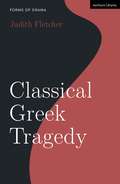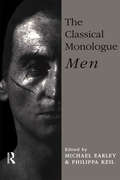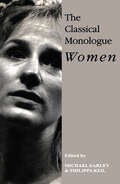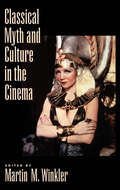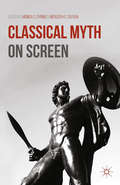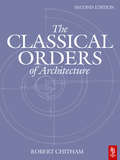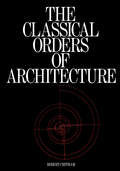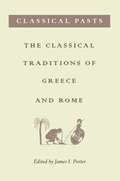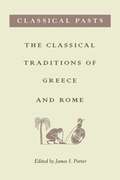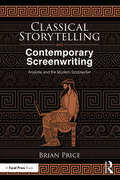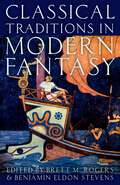- Table View
- List View
Classical Greek Tragedy (Forms of Drama)
by Judith FletcherClassical Greek Tragedy offers a comprehensive survey of the development of classical Greek tragedy combined with close readings of exemplary texts. Reconstructing how audiences in fifth-century BCE Athens created meaning from the performance of tragedy at the dramatic festivals sponsored by the city-state and its wealthiest citizens, it considers the context of Athenian political and legal structures, gender ideology, religious beliefs, and other social forces that contributed to spectators' reception of the drama. In doing so it focuses on the relationship between performers and watchers, not only Athenian male citizens, but also women and audiences throughout the ancient Mediterranean world.This book traces the historical development of these dynamics through three representative tragedies that span a 50 year period: Aeschylus' Seven Against Thebes, Sophocles' Oedipus Tyrannus, and Euripides' Helen. Topics include the role of the chorus; the tragic hero; recurring mythical characters and subject matter; Aristotelian assessments of the components of tragedy; developments in the architecture of the theater and their impact on the interactions of characters, and the spaces they occupy. Unifying these discussions is the observation that the genre articulates a reality beyond the visible stage action that intersects with the characters' existence in the present moment and resonates with the audience's religious beliefs and collective psychology. Human voices within the performance space articulate powerful forces from an invisible dimension that are activated by oaths, hymns, curses and prayers, and respond in the form of oracles and prophecies, forms of discourse which were profoundly meaningful to those who watched the original productions of tragedy.
Classical Greek Tragedy (Forms of Drama)
by Judith FletcherClassical Greek Tragedy offers a comprehensive survey of the development of classical Greek tragedy combined with close readings of exemplary texts. Reconstructing how audiences in fifth-century BCE Athens created meaning from the performance of tragedy at the dramatic festivals sponsored by the city-state and its wealthiest citizens, it considers the context of Athenian political and legal structures, gender ideology, religious beliefs, and other social forces that contributed to spectators' reception of the drama. In doing so it focuses on the relationship between performers and watchers, not only Athenian male citizens, but also women and audiences throughout the ancient Mediterranean world.This book traces the historical development of these dynamics through three representative tragedies that span a 50 year period: Aeschylus' Seven Against Thebes, Sophocles' Oedipus Tyrannus, and Euripides' Helen. Topics include the role of the chorus; the tragic hero; recurring mythical characters and subject matter; Aristotelian assessments of the components of tragedy; developments in the architecture of the theater and their impact on the interactions of characters, and the spaces they occupy. Unifying these discussions is the observation that the genre articulates a reality beyond the visible stage action that intersects with the characters' existence in the present moment and resonates with the audience's religious beliefs and collective psychology. Human voices within the performance space articulate powerful forces from an invisible dimension that are activated by oaths, hymns, curses and prayers, and respond in the form of oracles and prophecies, forms of discourse which were profoundly meaningful to those who watched the original productions of tragedy.
The Classical Hollywood Reader
by Steve NealeThe Classical Hollywood Reader brings together essential readings to provide a history of Hollywood from the 1910s to the mid 1960s. Following on from a Prologue that discusses the aesthetic characteristics of Classical Hollywood films, Part 1 covers the period between the 1910s and the mid-to-late 1920s. It deals with the advent of feature-length films in the US and the growing national and international dominance of the companies responsible for their production, distribution and exhibition. In doing so, it also deals with film making practices, aspects of style, the changing roles played by women in an increasingly business-oriented environment, and the different audiences in the US for which Hollywood sought to cater. Part 2 covers the period between the coming of sound in the mid 1920s and the beginnings of the demise of the `studio system` in late 1940s. In doing so it deals with the impact of sound on films and film production in the US and Europe, the subsequent impact of the Depression and World War II on the industry and its audiences, the growth of unions, and the roles played by production managers and film stars at the height of the studio era. Part 3 deals with aspects of style, censorship, technology, and film production. It includes articles on the Production Code, music and sound, cinematography, and the often neglected topic of animation. Part 4 covers the period between 1946 and 1966. It deals with the demise of the studio system and the advent of independent production. In an era of demographic and social change, it looks at the growth of drive-in theatres, the impact of television, the advent of new technologies, the increasing importance of international markets, the Hollywood blacklist, the rise in art house imports and in overseas production, and the eventual demise of the Production Code. Designed especially for courses on Hollywood Cinema, the Reader includes a number of newly researched and written chapters and a series of introductions to each of its parts. It concludes with an epilogue, a list of resources for further research, and an extensive bibliography.
The Classical Hollywood Reader
by Steve NealeThe Classical Hollywood Reader brings together essential readings to provide a history of Hollywood from the 1910s to the mid 1960s. Following on from a Prologue that discusses the aesthetic characteristics of Classical Hollywood films, Part 1 covers the period between the 1910s and the mid-to-late 1920s. It deals with the advent of feature-length films in the US and the growing national and international dominance of the companies responsible for their production, distribution and exhibition. In doing so, it also deals with film making practices, aspects of style, the changing roles played by women in an increasingly business-oriented environment, and the different audiences in the US for which Hollywood sought to cater. Part 2 covers the period between the coming of sound in the mid 1920s and the beginnings of the demise of the `studio system` in late 1940s. In doing so it deals with the impact of sound on films and film production in the US and Europe, the subsequent impact of the Depression and World War II on the industry and its audiences, the growth of unions, and the roles played by production managers and film stars at the height of the studio era. Part 3 deals with aspects of style, censorship, technology, and film production. It includes articles on the Production Code, music and sound, cinematography, and the often neglected topic of animation. Part 4 covers the period between 1946 and 1966. It deals with the demise of the studio system and the advent of independent production. In an era of demographic and social change, it looks at the growth of drive-in theatres, the impact of television, the advent of new technologies, the increasing importance of international markets, the Hollywood blacklist, the rise in art house imports and in overseas production, and the eventual demise of the Production Code. Designed especially for courses on Hollywood Cinema, the Reader includes a number of newly researched and written chapters and a series of introductions to each of its parts. It concludes with an epilogue, a list of resources for further research, and an extensive bibliography.
Classical Japanese Cinema Revisited
by Catherine RussellCatherine Russell's highly accessible book approaches Japanese cinema as an industry closely modeled on Hollywood, focusing on the classical period - those years in which the studio system dominated all film production in Japan, from roughly 1930 to 1960. Respectful and thoroughly informed about the aesthetics and critical values of the Japanese canon, Russell is also critical of some of its ideological tendencies, and her analyses provide new insights on class and gender dynamics. Russell locates Japanese cinema within a global system of reception, and she highlights the importance of the industrial production context of these films. Including studies of landmark films by Ozu, Kurosawa and other directors, this book provides a perfect introduction to a crucial and often misunderstood area of Japanese cultural output. With a critical approach that highlights the "everydayness" of Japanese studio-era cinema, Catherine Russell demystifies the canon of great Japanese cinema, treating it with fewer auteurist and Orientalist assumptions than many other scholars and critics.
Classical Japanese Cinema Revisited
by Catherine RussellCatherine Russell's highly accessible book approaches Japanese cinema as an industry closely modeled on Hollywood, focusing on the classical period - those years in which the studio system dominated all film production in Japan, from roughly 1930 to 1960. Respectful and thoroughly informed about the aesthetics and critical values of the Japanese canon, Russell is also critical of some of its ideological tendencies, and her analyses provide new insights on class and gender dynamics. Russell locates Japanese cinema within a global system of reception, and she highlights the importance of the industrial production context of these films. Including studies of landmark films by Ozu, Kurosawa and other directors, this book provides a perfect introduction to a crucial and often misunderstood area of Japanese cultural output. With a critical approach that highlights the "everydayness" of Japanese studio-era cinema, Catherine Russell demystifies the canon of great Japanese cinema, treating it with fewer auteurist and Orientalist assumptions than many other scholars and critics.
Classical Masculinity and the Spectacular Body on Film: The Mighty Sons of Hercules
by D. O'BrienThe muscle-bound male body is a perennial feature of classically-inflected action cinema. This book reassesses these films as a cinematic form, focusing on the depiction of heroic masculinity. In particular, Hercules in his many incarnations has greatly influenced popular cultural interpretations of manliness and the exaggerated male form.
The Classical Monologue (M): Men
by Michael Earley Philippa KeilThe Classical Monologue in two volumes, one for men and one for women, is a fresh selection of the best speeches from the repertoire of the classical theatre, from the Greeks to the beginning of the 20th century. These great dramatic monologues--from all periods and styles, all varied in tone and genre--make an indispensable actor's companion for auditioning, rehearsing and performing. Each monologue is accompanied by textual notes explaining any unusual vocabulary or syntax, and by commentary in which the editors offer interpretative points and practical advice in preparing the speech for performance. Both beginners and experienced actors will find The Classical Monologue a treasury of theatrical riches waiting to be released on stage.
The Classical Monologue (M): Men
by Michael Earley Philippa KeilThe Classical Monologue in two volumes, one for men and one for women, is a fresh selection of the best speeches from the repertoire of the classical theatre, from the Greeks to the beginning of the 20th century. These great dramatic monologues--from all periods and styles, all varied in tone and genre--make an indispensable actor's companion for auditioning, rehearsing and performing. Each monologue is accompanied by textual notes explaining any unusual vocabulary or syntax, and by commentary in which the editors offer interpretative points and practical advice in preparing the speech for performance. Both beginners and experienced actors will find The Classical Monologue a treasury of theatrical riches waiting to be released on stage.
The Classical Monologue (W): Women
by Michael EarleyFirst Published in 1993. Routledge is an imprint of Taylor & Francis, an informa company.
The Classical Monologue (W): Women
by Michael Earley Philippa KeilFirst Published in 1993. Routledge is an imprint of Taylor & Francis, an informa company.
Classical Myth and Culture in the Cinema
Classical Myth and Culture in the Cinema is a collection of essays presenting a variety of approaches to films set in ancient Greece and Rome and to films that reflect archetypal features of classical literature. The diversity of content and theoretical stances found in this volume will make it required reading for scholars and students interested in interdisciplinary approaches to text and image, and for anyone interested in the presence of Greece and Rome in modern popular culture.
Classical Myth on Screen
by Monica S. Cyrino Meredith E. SafranAn examination of how screen texts embrace, refute, and reinvent the cultural heritage of antiquity, this volume looks at specific story-patterns and archetypes from Greco-Roman culture. The contributors offer a variety of perspectives, highlighting key cultural relay points at which a myth is received and reformulated for a particular audience.
The Classical Orders of Architecture
by Robert ChithamThis is the only publication that presents a modern interpretation of the Classical Orders. The new edition of this successful title now includes the proportions in both metric and imperial measurements to make the orders more accessible and to provide a valuable reference for designers.The inclusion of both 100-part and 96-part systems of proportion is underpinned by an essay on James Gibbs - one of the 18th century authors of standardized proportioning systems - and his influence in America. Along with additional plates, this book gives aclear introduction to those not familiar with the classical genre and is an easy to follow guide which assists architects, interior designers and conservators with the quality of their design.
The Classical Orders of Architecture
by Robert ChithamThis is the only publication that presents a modern interpretation of the Classical Orders. The new edition of this successful title now includes the proportions in both metric and imperial measurements to make the orders more accessible and to provide a valuable reference for designers.The inclusion of both 100-part and 96-part systems of proportion is underpinned by an essay on James Gibbs - one of the 18th century authors of standardized proportioning systems - and his influence in America. Along with additional plates, this book gives aclear introduction to those not familiar with the classical genre and is an easy to follow guide which assists architects, interior designers and conservators with the quality of their design.
The Classical Orders of Architecture
by Robert ChithamThe Classical Orders of Architecture elaborates on the classical orders of architecture, including Classicism, Tuscan orders, Doric orders, Ionic orders, and Corinthian orders. The publication first examines the teaching of the orders, need for a new handbook of the orders, Roman and Renaissance theorists, traditional systems of proportion, and metric system of measurement. The text then ponders on historical background and orders in detail. Discussions focus on the Greek orders and comparative Tuscan orders, Doric orders, Ionic orders, Corinthian orders, and Composite orders. The book tackles the orders in detail, including the five orders, Tuscan order, Tuscan capital and entablature, Tuscan base and pedestal, Doric order, Doric base and pedestal, Ionic order and volute, Ionic capital and entablature, Ionic base and pedestal, and the Corinthian order. The manuscript then reviews the use of the orders, as well as diminution and fluting, rustication, pediments, moldings and their enrichment, and characteristics of Classicism. The text is a valuable source of information for architects, historians, and researchers interested in the classical orders of architecture.
The Classical Parthenon: Recovering the Strangeness of the Ancient World
by William St ClairComplementing Who Saved the Parthenon? this companion volume sets aside more recent narratives surrounding the Athenian Acropolis, supposedly ‘the very symbol of democracy itself’, instead asking if we can truly access an ancient past imputed with modern meaning. And, if so, how? In this book William St Clair presents a reconstructed understanding of the Parthenon from within the classical Athenian worldview. He explores its role and meaning by weaving together a range of textual and visual sources into two innovative oratorical experiments – a speech in the style of Thucydides and a first-century CE rhetorical exercise – which are used to develop a narrative analysis of the temple structure, revealing a strange story of indigeneity, origins, and empire. The Classical Parthenon offers new answers to old questions, such as the riddle of the Parthenon frieze, and provides a framing device for the wider relationship between visual artefacts, built heritage, and layers of accumulated cultural rhetoric. This groundbreaking and pertinent work will appeal across the disciplines to readers interested in the classics, art history, and the nature of history, while also speaking to a general audience that is interrogating the role of monuments in contemporary society.
Classical Pasts: The Classical Traditions of Greece and Rome
by James I. PorterThe term "classical" is used to describe everything from the poems of Homer to entire periods of Greek and Roman antiquity. But just how did the concept evolve? This collection of essays by leading classics scholars from the United States and Europe challenges the limits of the current understanding of the term. The book seeks not to arrive at a final definition, but rather to provide a cultural history of the concept by exploring how the meanings of "classical" have been created, recreated, and rejected over time. The book asks questions that have been nearly absent from the scholarly literature. Does "classical" refer to a specific period of history or to the artistic products of that time? How has its definition changed? Did those who lived in classical times have some understanding of what the term "classical" has meant? How coherent, consistent, or even justified is the term? The book's introduction provides a generous theoretical and historical overview. It is followed by eleven chapters in which the contributors argue for the existence not of a single classical past, but of multiple, competing classical pasts. The essays address a broad range of topics--Homer and early Greek poetry and music, Isocrate, Hellenistic and Roman art, Cicero and Greek philosophy, the history of Latin literature, imperial Greek literature, and more. The most up-to-date and challenging treatment of the topic available, this collection will be of lasting interest to students and scholars of ancient and modern literature, art, and cultural history.
Classical Pasts: The Classical Traditions of Greece and Rome (PDF)
by Jamesjames I. PorterThe term "classical" is used to describe everything from the poems of Homer to entire periods of Greek and Roman antiquity. But just how did the concept evolve? This collection of essays by leading classics scholars from the United States and Europe challenges the limits of the current understanding of the term. The book seeks not to arrive at a final definition, but rather to provide a cultural history of the concept by exploring how the meanings of "classical" have been created, recreated, and rejected over time. The book asks questions that have been nearly absent from the scholarly literature. Does "classical" refer to a specific period of history or to the artistic products of that time? How has its definition changed? Did those who lived in classical times have some understanding of what the term "classical" has meant? How coherent, consistent, or even justified is the term? The book's introduction provides a generous theoretical and historical overview. It is followed by eleven chapters in which the contributors argue for the existence not of a single classical past, but of multiple, competing classical pasts. The essays address a broad range of topics--Homer and early Greek poetry and music, Isocrate, Hellenistic and Roman art, Cicero and Greek philosophy, the history of Latin literature, imperial Greek literature, and more. The most up-to-date and challenging treatment of the topic available, this collection will be of lasting interest to students and scholars of ancient and modern literature, art, and cultural history.
Classical Projections: The Practice and Politics of Film Quotation
by Eleni PalisQuotations are a standard way that the humanities make meaning; the pull-quote, epigraph, and quotation are standard for citing evidence and invoking and interrogating authority in both literary and scholarly writing. However, film studies has yet to seriously examine how moving images can quote one another, convening interaction and creating new knowledge across time. Classical Projections offers "film quotation" as a new concept for understanding how preexisting moving image fragments are reframed and re-viewed within subsequent films. As a visual corollary to literary quotation, film quotations embed film fragments in on-screen movie screens. Though film quotations have appeared since silent cinema, Classical Projections focuses on quotations of classical Hollywood film--mainstream American studio production, 1915-1950--as quoted in post-classical Hollywood, roughly 1960 to present. This strategic historical frame asks: how does post-classical cinema visualize its awareness of coming after a classical or golden age? How do post-classical filmmakers claim or disavow classical history? How do historically disenfranchised post-classical filmmakers, whether by gender, sexuality, or race, grapple with exclusionary and stereotype-ridden canons? As a constitutive element of post-classical authorship, film quotations amass and manufacture classical Hollywood in retrospective, highly strategic ways. By revealing how quotational tellings of film history build and embolden exclusionary, myopic canons, Classical Projections uncovers opportunities to construct more capacious cultural memory.
Classical Projections: The Practice and Politics of Film Quotation
by Eleni PalisQuotations are a standard way that the humanities make meaning; the pull-quote, epigraph, and quotation are standard for citing evidence and invoking and interrogating authority in both literary and scholarly writing. However, film studies has yet to seriously examine how moving images can quote one another, convening interaction and creating new knowledge across time. Classical Projections offers "film quotation" as a new concept for understanding how preexisting moving image fragments are reframed and re-viewed within subsequent films. As a visual corollary to literary quotation, film quotations embed film fragments in on-screen movie screens. Though film quotations have appeared since silent cinema, Classical Projections focuses on quotations of classical Hollywood film--mainstream American studio production, 1915-1950--as quoted in post-classical Hollywood, roughly 1960 to present. This strategic historical frame asks: how does post-classical cinema visualize its awareness of coming after a classical or golden age? How do post-classical filmmakers claim or disavow classical history? How do historically disenfranchised post-classical filmmakers, whether by gender, sexuality, or race, grapple with exclusionary and stereotype-ridden canons? As a constitutive element of post-classical authorship, film quotations amass and manufacture classical Hollywood in retrospective, highly strategic ways. By revealing how quotational tellings of film history build and embolden exclusionary, myopic canons, Classical Projections uncovers opportunities to construct more capacious cultural memory.
Classical Storytelling and Contemporary Screenwriting: Aristotle and the Modern Scriptwriter
by Brian PriceSince we first arrived on the planet, we’ve been telling each other stories, whether of that morning’s great saber-tooth tiger hunt or the latest installment of the Star Wars saga. And throughout our history, despite differences of geography or culture, we’ve been telling those stories in essentially the same way. Why? Because there is a RIGHT way to tell a story, one built into our very DNA. In his seminal work Poetics, Aristotle identified the patterns and recurring elements that existed in the successful dramas of his time as he explored precisely why we tell stories, what makes a good one, and how to best tell them. In Classical Storytelling and Contemporary Screenwriting, Brian Price examines Aristotle’s conclusions in an entertaining and accessible way and then applies those guiding principles to the most modern of storytelling mediums, going from idea to story to structure to outline to final pages and beyond, covering every relevant screenwriting topic along the way. The result is a fresh new approach to the craft of screenwriting—one that’s only been around a scant 2,500 years or so—ideal for students and aspiring screenwriters who want a comprehensive step-by-step guide to writing a successful screenplay the way the pros do it.
Classical Storytelling and Contemporary Screenwriting: Aristotle and the Modern Scriptwriter
by Brian PriceSince we first arrived on the planet, we’ve been telling each other stories, whether of that morning’s great saber-tooth tiger hunt or the latest installment of the Star Wars saga. And throughout our history, despite differences of geography or culture, we’ve been telling those stories in essentially the same way. Why? Because there is a RIGHT way to tell a story, one built into our very DNA. In his seminal work Poetics, Aristotle identified the patterns and recurring elements that existed in the successful dramas of his time as he explored precisely why we tell stories, what makes a good one, and how to best tell them. In Classical Storytelling and Contemporary Screenwriting, Brian Price examines Aristotle’s conclusions in an entertaining and accessible way and then applies those guiding principles to the most modern of storytelling mediums, going from idea to story to structure to outline to final pages and beyond, covering every relevant screenwriting topic along the way. The result is a fresh new approach to the craft of screenwriting—one that’s only been around a scant 2,500 years or so—ideal for students and aspiring screenwriters who want a comprehensive step-by-step guide to writing a successful screenplay the way the pros do it.
Classical Traditions in Modern Fantasy
Classical Traditions in Modern Fantasy is the first collection of essays in English focusing on how fantasy draws deeply on ancient Greek and Roman mythology, philosophy, literature, history, art, and cult practice. Presenting fifteen all-new essays intended for both scholars and other readers of fantasy, this volume explores many of the most significant examples of the modern genre-including the works of H. P. Lovecraft, J. R. R. Tolkien's The Hobbit, C. S. Lewis's Chronicles of Narnia, J. K. Rowling's Harry Potter series, George R. R. Martin's Game of Thrones series, and more-in relation to important ancient texts such as Aeschylus' Oresteia, Aristotle's Poetics, Virgil's Aeneid, and Apuleius' The Golden Ass. These varied studies raise fascinating questions about genre, literary and artistic histories, and the suspension of disbelief required not only of readers of fantasy but also of students of antiquity. Ranging from harpies to hobbits, from Cyclopes to Cthulhu, and all manner of monster and myth in-between, this comparative study of Classics and fantasy reveals deep similarities between ancient and modern ways of imagining the world. Although antiquity and the present day differ in many ways, at its base, ancient literature resonates deeply with modern fantasy's image of worlds in flux and bodies in motion.
CLASSICAL TRADITIONS IN MODERN FANTASY C
by Brett M. Rogers and Benjamin Eldon StevensClassical Traditions in Modern Fantasy is the first collection of essays in English focusing on how fantasy draws deeply on ancient Greek and Roman mythology, philosophy, literature, history, art, and cult practice. Presenting fifteen all-new essays intended for both scholars and other readers of fantasy, this volume explores many of the most significant examples of the modern genre-including the works of H. P. Lovecraft, J. R. R. Tolkien's The Hobbit, C. S. Lewis's Chronicles of Narnia, J. K. Rowling's Harry Potter series, George R. R. Martin's Game of Thrones series, and more-in relation to important ancient texts such as Aeschylus' Oresteia, Aristotle's Poetics, Virgil's Aeneid, and Apuleius' The Golden Ass. These varied studies raise fascinating questions about genre, literary and artistic histories, and the suspension of disbelief required not only of readers of fantasy but also of students of antiquity. Ranging from harpies to hobbits, from Cyclopes to Cthulhu, and all manner of monster and myth in-between, this comparative study of Classics and fantasy reveals deep similarities between ancient and modern ways of imagining the world. Although antiquity and the present day differ in many ways, at its base, ancient literature resonates deeply with modern fantasy's image of worlds in flux and bodies in motion.
